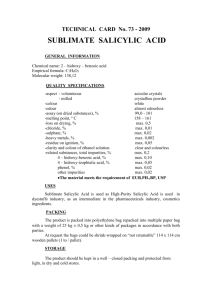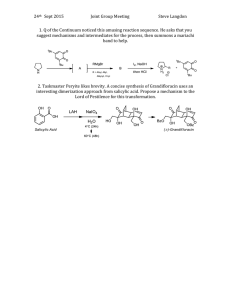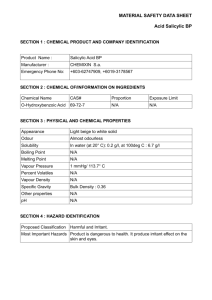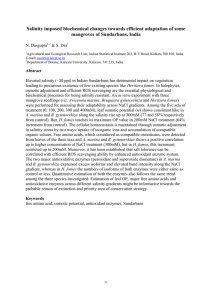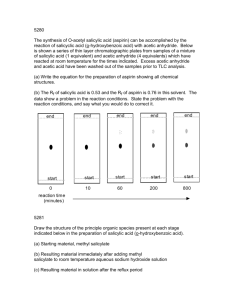The beneficial effect of salicylic acid on rose plants exposed to
advertisement
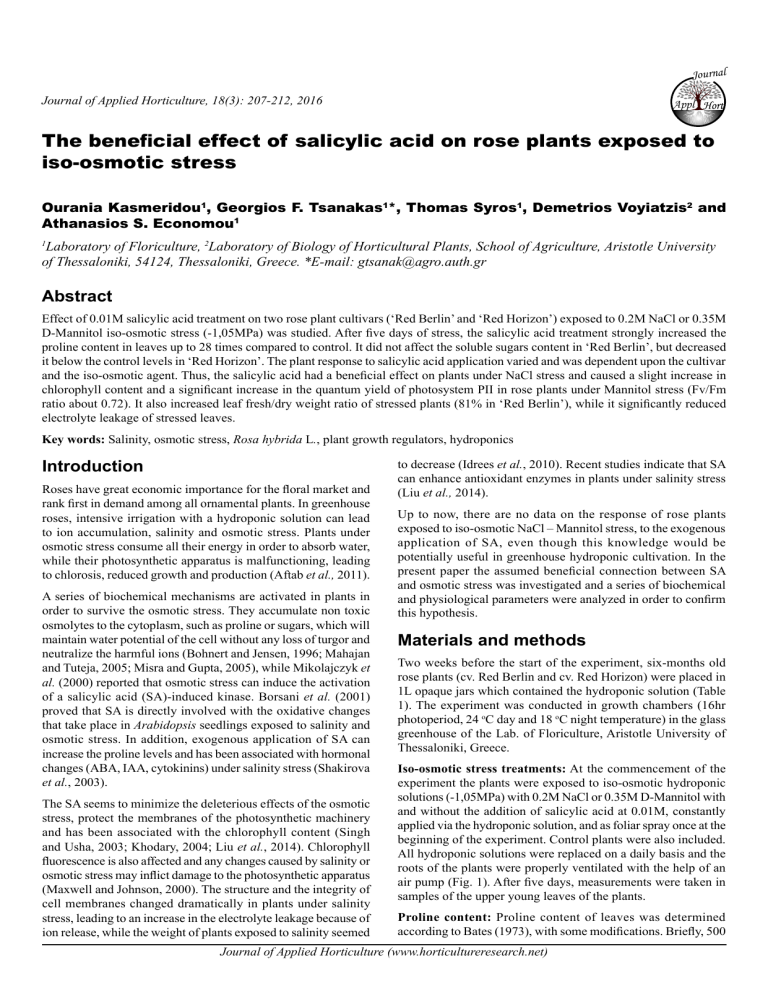
Journal Journal of Applied Horticulture, 18(3): 207-212, 2016 Appl The beneficial effect of salicylic acid on rose plants exposed to iso-osmotic stress Ourania Kasmeridou1, Georgios F. Tsanakas1*, Thomas Syros1, Demetrios Voyiatzis2 and Athanasios S. Economou1 Laboratory of Floriculture, 2Laboratory of Biology of Horticultural Plants, School of Agriculture, Aristotle University of Thessaloniki, 54124, Thessaloniki, Greece. *E-mail: gtsanak@agro.auth.gr 1 Abstract Effect of 0.01M salicylic acid treatment on two rose plant cultivars (‘Red Berlin’ and ‘Red Horizon’) exposed to 0.2M NaCl or 0.35M D-Mannitol iso-osmotic stress (-1,05MPa) was studied. After five days of stress, the salicylic acid treatment strongly increased the proline content in leaves up to 28 times compared to control. It did not affect the soluble sugars content in ‘Red Berlin’, but decreased it below the control levels in ‘Red Horizon’. The plant response to salicylic acid application varied and was dependent upon the cultivar and the iso-osmotic agent. Thus, the salicylic acid had a beneficial effect on plants under NaCl stress and caused a slight increase in chlorophyll content and a significant increase in the quantum yield of photosystem PII in rose plants under Mannitol stress (Fv/Fm ratio about 0.72). It also increased leaf fresh/dry weight ratio of stressed plants (81% in ‘Red Berlin’), while it significantly reduced electrolyte leakage of stressed leaves. Key words: Salinity, osmotic stress, Rosa hybrida L., plant growth regulators, hydroponics Introduction Roses have great economic importance for the floral market and rank first in demand among all ornamental plants. In greenhouse roses, intensive irrigation with a hydroponic solution can lead to ion accumulation, salinity and osmotic stress. Plants under osmotic stress consume all their energy in order to absorb water, while their photosynthetic apparatus is malfunctioning, leading to chlorosis, reduced growth and production (Aftab et al., 2011). A series of biochemical mechanisms are activated in plants in order to survive the osmotic stress. They accumulate non toxic osmolytes to the cytoplasm, such as proline or sugars, which will maintain water potential of the cell without any loss of turgor and neutralize the harmful ions (Bohnert and Jensen, 1996; Mahajan and Tuteja, 2005; Misra and Gupta, 2005), while Mikolajczyk et al. (2000) reported that osmotic stress can induce the activation of a salicylic acid (SA)-induced kinase. Borsani et al. (2001) proved that SA is directly involved with the oxidative changes that take place in Arabidopsis seedlings exposed to salinity and osmotic stress. In addition, exogenous application of SA can increase the proline levels and has been associated with hormonal changes (ABA, IAA, cytokinins) under salinity stress (Shakirova et al., 2003). The SA seems to minimize the deleterious effects of the osmotic stress, protect the membranes of the photosynthetic machinery and has been associated with the chlorophyll content (Singh and Usha, 2003; Khodary, 2004; Liu et al., 2014). Chlorophyll fluorescence is also affected and any changes caused by salinity or osmotic stress may inflict damage to the photosynthetic apparatus (Maxwell and Johnson, 2000). The structure and the integrity of cell membranes changed dramatically in plants under salinity stress, leading to an increase in the electrolyte leakage because of ion release, while the weight of plants exposed to salinity seemed to decrease (Idrees et al., 2010). Recent studies indicate that SA can enhance antioxidant enzymes in plants under salinity stress (Liu et al., 2014). Up to now, there are no data on the response of rose plants exposed to iso-osmotic NaCl – Mannitol stress, to the exogenous application of SA, even though this knowledge would be potentially useful in greenhouse hydroponic cultivation. In the present paper the assumed beneficial connection between SA and osmotic stress was investigated and a series of biochemical and physiological parameters were analyzed in order to confirm this hypothesis. Materials and methods Two weeks before the start of the experiment, six-months old rose plants (cv. Red Berlin and cv. Red Horizon) were placed in 1L opaque jars which contained the hydroponic solution (Table 1). The experiment was conducted in growth chambers (16hr photoperiod, 24 oC day and 18 oC night temperature) in the glass greenhouse of the Lab. of Floriculture, Aristotle University of Thessaloniki, Greece. Iso-osmotic stress treatments: At the commencement of the experiment the plants were exposed to iso-osmotic hydroponic solutions (-1,05MPa) with 0.2M NaCl or 0.35M D-Mannitol with and without the addition of salicylic acid at 0.01M, constantly applied via the hydroponic solution, and as foliar spray once at the beginning of the experiment. Control plants were also included. All hydroponic solutions were replaced on a daily basis and the roots of the plants were properly ventilated with the help of an air pump (Fig. 1). After five days, measurements were taken in samples of the upper young leaves of the plants. Proline content: Proline content of leaves was determined according to Bates (1973), with some modifications. Briefly, 500 Journal of Applied Horticulture (www.horticultureresearch.net) 208 The beneficial effect of salicylic acid on rose plants exposed to iso-osmotic stress Table 1. The chemical composition of the hydroponic solution Nutrient (mmol) Nutrient (μmol) 11.5 Fe2+ 25 NO31.2 Mn2+ 7.5 NH4+ 5.2 Zn2+ 6.5 K+ 2+ 5.5 BO320 Ca 3.0 Cu2+ 1.3 Mg2+ 3.0 MoO41.1 SO42+ 1.4 H2PO4 0.4 EC: ~ 2mS/cm pH: ~5.8 HCO3- mg of fresh tissue were homogenized in 3% sulfosalicylic acid and centrifuged at 10,000 g at 4 oC for 10 min. Subsequently, 2 mL of the supernatant were transferred in a new tube and 1 mL of acetic ninhydrin and 2 mL of acetic acid were added. Samples were incubated in water bath for 1 hour at 80 oC and then placed in cold water bath. Four mL of toluene were added to every sample and short agitation followed. All samples were allowed for the two phases to separate for about half an hour and proline content (upper phase) was determined spectrophotometrically at 520 nm, with the help of standard curve. Soluble sugar content: Soluble sugar content of leaves was determined according to Dubois et al. (1956), with some modifications. In particular, 150 mg of fresh leaf tissue were incubated at room temperature in 5 mL of 80 % methanol. After 2 h, 250 μL of the solution were transferred in a new tube that contained 250 μL of 80 % methanol, 500 μL of 5 % phenol and 2.5 mL of sulfuric acid 96 %. Samples were cooled in water bath and sugar content was determined at 490 nm, with the help of standard curve (D-glucose). Chlorophyll content: Chlorophyll content of leaves was determined with a Chlorophyll Content Meter, CCM-200 (OptiSciences, Hudson, NH, USA). Relative chlorophyll content was expressed as CCI (Chlorophyll Content Index) units. Quantum yield of photosystem PII (Φp): Quantum yield of photosystem PII (Φp) was estimated as Fv/Fm = (Fm−Fo)/Fm Fig. 1. Rose plant of ‘Red Berlin’ inside the growth chamber, placed in opaque vase with the hydroponic solution. Pipes for proper ventilation can be seen. (Bolla et al., 2010) by measuring the leaf chlorophyll fluorescence with an OS-30p (OptiSciences, Hudson, USA) fluorometer, where Fo the initial fluorescence, Fm the maximum fluorescence and Fv the variable fluorescence calculated as: Fv = Fm – Fo. Electrolyte leakage: Electrolyte leakage was measured according to the method of Dionisio-Sese and Tobita (1998), with some modifications. In particular, five foliar discs of about 7 mm diameter were placed in 1.5 mL tubes with 1 mL of 0.3 M D-Mannitol solution. Samples were incubated at room temperature (25 °C) for 2 h and then the initial electrical conductivity of the medium (C1) was measured with a conductivity meter (Twin Cond Conductivity Meter B-173, Horiba). In order to completely kill the tissues and release all the electrolytes, the samples were placed in hot water bath (100 oC) for 10 min. After cooling the samples under running tap water, a second measurement was taken (C2) and the electrolyte leakage (%) was calculated by using the formula: Electrolyte leakage (%) = [ (C1 - Cman) / (C2 - Cman) ] x100, where Cman was the electrical conductivity of the 0.3 M D-mannitol solution. Leaf weight: For the estimation of the alteration (%) of the fresh/ dry weight ratio, the fresh weight of about 10 young leaves per plant was measured. Then, the leaves were dried in an incubator for 4 days at 80 oC and their dry weight was measured again. The fresh/dry weight ratio of the young leaves for every plant was expressed as a percentage of the control. Statistics: The experiment was conducted according to a randomized complete-block design with three replicates (one plant per replicate), each consisting of three leaves per plant, per treatment. Data were subjected to ANOVA (SPSS 19.0 software). Arcsin transformation of percentages was done prior to analysis, where needed. Results and discussion Because of the iso-osmotic stress, curling of the margins of the leaves (Figs. 2A-2B), peripheral leaf necrosis (Figs. 2C-2D) and Fig. 2. In the control rose plants of ‘Red Horizon’ the margins of the leaves are horizontal (A), while in the plants exposed to NaCl stress curling can be seen (B). Peripheral necrosis due to the presence of NaCl (C) and Mannitol (D) in the hydroponic solution. Journal of Applied Horticulture (www.horticultureresearch.net) The beneficial effect of salicylic acid on rose plants exposed to iso-osmotic stress NaCl+SA Control NaCl Fig. 3. The root system of ‘Red Berlin’ rose plants after 5 days exposure to iso-osmotic stress. browning of the root (Fig. 3) was observed. These are typical symptoms of plants that are exposed to this kind of stress and have been previously reported for other species, such as tomato (Manaa et al., 2014). On the other hand the roots of control plants and of those receiving the SA treatments remained white (Fig. 3). Proline content: The effect of iso-osmotic stress and SA on the proline content of the young leaves of rose plants is shown in Fig. 4. After five days of stress, the proline content of the young leaves significantly increased in both cultivars. The response of rose plants to the NaCl stress, was an increase in their proline content by x3 - x12 times compared to the control, while under Mannitol stress this increase was about x8 - x12 times. Similar results have been found by Roy and Chakraborty (2015), in Bermuda grass under severe NaCl stress for a short period. Application of SA to the stressed plants further increased their proline levels. At NaCl stress + SA treatment the proline content was about x6 - x28 times that of the control, while at Mannitol + SA the increase was about x11 - x15 times more. The mechanism of action of SA seems to be associated with significant changes in the hormonal status of Fig. 4. Effect of SA on the proline content in leaves of ‘Red Berlin’ and ‘Red Horizon’, after five days of iso-osmotic stress. Fold change (x) is estimated according to the control, while different letters refer to statistical significant differences. Data are means ± SE. Mannitol 209 Mannitol+SA the stressed plant. Kishor et al. (2005) reviewed the positive role of abscisic acid treatment in proline accumulation under salinity stress, while according to Shakirova et al. (2003) the application of SA enhanced the accumulation of abscisic acid (ABA). SA also seems to play a key role in plant tolerance via the activation of the enzymes of the antioxidant mechanism (Levent Tuna et al., 2007; Simaei et al., 2011). Soluble sugar content: Soluble sugar content increased under NaCl or Mannitol stress in both cultivars. Rose plants, exposed to NaCl stress, showed a significant increase in their sugar content by x2 times more than the control levels, while a similar increase was observed in the Mannitol treatment (about x2 – x3 times) (Fig. 5). The accumulation of sugars under salinity or osmotic stress allows turgor maintenance and/or protection of macromolecular structure against the destabilizing effect of saline water (Murakeozy et al., 2003; Juan et al., 2005). The application of SA to the iso-osmotically stressed ‘Red Berlin’ plants (NaCl +SA and Mannitol +SA) reduced sugar content to control levels, while in ‘Red Horizon’ the sugar content was decreased below Fig. 5. Effect of SA on the soluble sugar content of leaves of ‘Red Berlin’ and ‘Red Horizon’, after five days of iso-osmotic stress. Fold change (x or %) is estimated according to the control, while different letters refer to statistical significant differences. Data are means ± SE. Journal of Applied Horticulture (www.horticultureresearch.net) 210 The beneficial effect of salicylic acid on rose plants exposed to iso-osmotic stress the control levels (73% at NaCl and 31% at Mannitol stress). This effect of SA is not uncommon. Khodary (2004) reported similar results and hypothesized that SA activates the metabolic consumption of soluble sugars to form new cell constituents as a mechanism to stimulate the growth of the plant. The findings of this research seemed to agree with this theory. Chlorophyll content: Chlorophyll content decreased significantly in all iso-osmotic treatments (Fig. 6) followed by chlorosis and peripheral necrosis of the leaves (Figs. 2C and 2D). Under NaCl stress, chlorophyll content decreased at about half of the control (65-49%), while at Mannitol stress the chlorophyll levels varied between 82 and 27% of that of the control. When SA was applied, plants under NaCl stress responded with an increase in their chlorophyll content, although it was still lower than the control levels (81-68%). Under Mannitol stress, the SA treatment did not change significantly the chlorophyll content in both cultivars. Syros et al. (2004) found that chlorophyll content in gerbera leaves was significantly reduced when plants were exposed to water stress. Chlorophyll reduction is attributed to a proline increase. Le Dily et al. (1993) suggested that these two compounds have a common precursor, glutamate, and this may explain the negative correlation found in the present work between proline and chlorophyll content, while similar results were reported by Soussi et al. (1998), who also reported a significant decrease in the activity of RubisCO. SA caused an increase in chlorophyll content, though below control levels, in Fig. 6. Effect of SA on the chlorophyll content index (CCI units), of leaves of ‘Red Berlin’ and ‘Red Horizon’, after five days of iso-osmotic stress. Fold change (%) is estimated according to the control, while different letters refer to statistical significant differences. Data are means ± SE. NaCl-stressed plants. This is not the first report of SA increasing chlorophyll. Arfan et al. (2007) found similar results in wheat and they assumed a beneficial role of SA treatment in the activity of RubisCO or PEP carboxylase. However, SA could not ameliorate the effect of mannitol stress. Similarly, SA could not play a protective role in mutant Arabidopsis seedlings under severe NaCl or Mannitol stress, if not in sufficient concentrations (Borsani et al., 2001). In this study 0.35M of D-Mannitol was added to the hydroponic solution, which is usually considered causing severe osmotic stress, leading to the conclusion that maybe a significantly higher amount of SA should have been used in order to elicit a detectable response. Quantum yield of photosystem PII (Φp): Quantum yield of photosystem II (Φp) was significantly decreased under all isoosmotic stress treatments. In ‘Red Berlin’, the Fv/Fm ratio was about the 93 % of the control, while in ‘Red Horizon’ the Fv/Fm ratio was about 88-91% of the non treated plants (Fig. 7). The application of SA helped the mechanism to recover. The response of the plants to the exogenous application of SA varied from a slight increase in Φp in NaCl + SA and in Mannitol +SA in both cultivars, to full recovery in Mannitol +SA in ‘Red Berlin’. According to Bolla et al. (2010) the decrease in quantum yield of photosystem PII in rose plants is due to PII being the most vulnerable part of the photosynthetic apparatus to injuries so that any damages caused by salinity or osmotic stress are inflicted there (Maxwell and Johnson, 2000). In this work, SA appeared to protect the photosynthetic mechanism - PII of the plants exposed to iso-osmotic stress. Liu et al. (2014) proposed that SA can Fig. 7. Effect of SA on the Fv/Fm ratio in leaves of ‘Red Berlin’ and ‘Red Horizon’, after five days of iso-osmotic stress. Fold change (%) is estimated according to the control, while different letters refer to statistical significant differences. Data are means ± SE. Journal of Applied Horticulture (www.horticultureresearch.net) The beneficial effect of salicylic acid on rose plants exposed to iso-osmotic stress 211 scavenge leaf ROS, protect chlorophyll synthesis and improve photosystem functioning and this hypothesis seems to agree with the Φp findings of this research, and also with the significant increase in chlorophyll content (Fig. 6). Electrolyte leakage: NaCl and Mannitol stress strongly increased the electrolyte leakage in both cultivars (Fig. 8). NaCl stress led to a more than x2 times increase in membrane leakage (more than 70%), causing fatal injury to the plant canopy (Figs. 2C and 2D). The effect of Mannitol on plant membranes was similar and resulted to 35 - 50% leakage. SA application caused a significant decrease in the electrolyte leakage in NaCl stressed plants of both cultivars but had no significant effect on Mannitol stressed plants. In both cases the leakage levels were still significantly higher than that of the controls in both cultivars. This is not the first time that SA seems to exert a protective influence on plant membranes. A hypothesis that SA induces the antioxidant response and elevates Ca uptake, which protects the plant from the oxidative damage, as part of the activation of a multiple stress tolerance mechanism, has been proposed (Senaratna et al., 2000; El-Tayeb, 2005; Karlidag et al., 2009; Bayat et al., 2012). Leakage (%) Leakage (%) Leaf weight: The alteration in fresh/dry weight ratio for both cultivars is shown in Fig. 9. Under NaCl stress this ratio has been decreased to half of that of the control (63-56 %). Part of this decrease might be attributed to NaCl toxicity (Niu et al., 2008). Mannitol stress had a less severe effect on weight ratio, ‘Red Berlin’ being less affected than ‘Red Horizon’ (73-64 %). Rahi and Singh (2011) observed a similar decrease in the dry weight of Chrysanthemum under salinity stress, Zivdar et al. (2011) in Zinnia and Rao and Shahid (2011) in Gaillardia. Fig. 8. Effect of SA on the electrolyte leakage of leaf tissue, of ‘Red Berlin’ and ‘Red Horizon’, after five days of iso-osmotic stress. Fold change (x) is estimated according to the control, while different letters refer to statistical significant differences. Data are means ± SE. Fig. 9. Effect of SA on the % alteration of fresh/dry weight ratio, of leaves of ‘Red Berlin’ and ‘Red Horizon’, after five days of iso-osmotic stress. Fold change (%) is estimated according to the control, while different letters refer to statistical significant differences. Data are means ± SE. Exogenous application of SA caused an increase in the weight ratio of rose leaves under stress that was still significantly less than the control. Under NaCl stress, SA treatment caused an increase in leaf weight ratio by +9 % in ‘Red Berlin’ and by +2 % in ‘Red Horizon’, while Mannitol caused a similar increase by 8 and 4 %, respectively. Idrees et al. (2010) have also observed an increase in leaf weight of lemongrass treated with SA and they hypothesized that SA favors photosynthesis that ultimately results to a significant increase in leaf weight and in the overall growth of the plant. This hypothesis could explain the results of the present research, since SA application seemed to have a beneficial role in the photosynthetic machinery which resulted in an increase in leaf weight. In conclusion, an attempt was made to investigate the effect of salicylic acid, exogenously applied, on rose plants grown under severe salinity and osmotic stress conditions. Salicylic acid treatment clearly increased the proline levels under iso-osmotic stress caused by NaCl or Mannitol, in both cultivars tested. The application of salicylic acid to plants exposed to NaCl also had a positive effect on chlorophyll content, quantum yield of PII, electrolyte leakage and on leaf weight. Osmotic stress appeared to affect, in both cvs, plant growth (leaf fresh/dry weight ratio) through a detrimental effect mainly on the photosynthetic apparatus (chlorophyll content and photosynthetic efficiency). In this respect, ‘Red Berlin’ appeared in a better position to fend off the osmotic stress shock, than ‘Red Horizon’. Because of the seemingly great practical potential these findings might have in hydroponic cultivation of roses, further research is needed to clarify the effect of SA on the photosynthetic machinery and Journal of Applied Horticulture (www.horticultureresearch.net) 212 The beneficial effect of salicylic acid on rose plants exposed to iso-osmotic stress yield (number of flower shoots per plant, shoot length and quality) and postharvest life of the flower. In order to fully elucidate this mechanism, reactive oxygen species and the antioxidant mechanism should also be further studied, while a more detailed biological approach could give the full picture of the hormonal pathway and the gene networks involved. References Aftab, T., M.M.A. Khan, J.A. Teixeiira daSilva, M. Idrees, M. Naeem and Moinuddin, 2011. Role of salicylic acid in promoting salt stress tolerance and enhanced artemisinin production in Artemisia annua L. J. Plant Growth Regul., 30: 425-435. Arfan, M., H.R. Athar and M. Ashraf, 2007. Does exogenous application of salicylic acid through the rooting medium modulate growth and photosynthetic capacity in two differently adapted spring wheat cultivars under salt stress? J.Plant Physiol., 164: 685-694. Bates, L.S. 1973. Rapid determination of free proline for water - stress studies. Plant Soil, 39: 205-207. Bayat, H., M. Alirezaie and H. Neamati, 2012. Impact of exogenous salicylic acid on growth and ornamental characteristics of calendula (Calendula officinalis L.) under salinity stress. J. Stress Physiol. Biochem., 8(1): 258-267. Bohnert, H.J. and R.G. Jensen, 1996. Strategies for engineering waterstress tolerance in plants. Trends Biotechnol., 14(3): 89-97. Bolla, A., D. Voyiatzis, M. Koukourikou-Petridou and D. Chimonidou, 2010. Photosynthetic parameters and cut-flower yield of rose “Eurored” (H.T.) are adversely affected by mild water stress irrespective of substrate composition. Scientia Hort., 126: 390-394. Borsani, O., V. Valpuesta and M.A. Botella, 2001. Evidence for a role of salicylic acid in the oxidative damage generated by NaCl and osmotic stress in arabidopsis seedlings. Plant Physiol., 126: 1024-1030. Dionisio-Sese, M.L. and S. Tobita, 1998. Antioxidant responses of rice seedlings to salinity stress. Plant Sci., 135: 1-9. Dubois, M., K.A. Gilles, J.K. Hamilton, P.A. Rebers and F. Smith, 1956. Colorimetric method for determination of sugars and related substances. Anal. Chem., 28: 350-356. El-Tayeb, M.A. 2005. Response of barley grains to the interactive effect of salinity and salicylic acid. Plant Growth Regul., 45: 215-224. Idrees, M., M.M.A. Khan, T. Aftab, M. Naeem and N. Hashmi, 2010. Salicylic acid-induced physiological and biochemical changes in lemongrass varieties under water stress. J. Plant Interactions, 5: 293-303. Juan, M., R.M. Rivero, L. Romero and J.M. Ruiz, 2005. Evaluation of some nutritional and biochemical indicators in selecting salt-resistant tomato cultivars. Environ. Expt. Bot., 54: 193-201. Karlidag, H., E. Yildirim and M. Turan, 2009. Salicylic acid ameliorates the adverse effect of salt stress on strawberry. Scientia Agricola (Piracicaba, Brazil), 66(2): 180-187. Khodary, S.E.A. 2004. Effect of salicylic acid on the growth, photosynthesis and carbohydrate metabolism in salt stressed maize plants. Int. J. Agr.Biol., 6(1): 5-8. Kishor, P.B.K., S. Sangam, R.N. Amrutha, P. Sri Laxmi, K.R. Naidu, K.R.S.S. Rao, S. Rao, K.J. Reddy, P. Theriappan and N. Sreenivasulu, 2005. Regulation of proline biosynthesis, degradation, uptake and transport in higher plants: Its implications in plant growth and abiotic stress tolerance. Current Sci., 88(3): 424-438. Le Dily, F., J.B. Billard, J. Le Saos and C. Huault, 1993. Effects of NaCl and gabaculine on chlorophyll and proline levels during growth or radish cotyledons. Plant Physiol. Biochem., 31: 301-310. Levent Tuna, A., C. Kaya, M. Dikilitas, I. Yokas, B. Burun and H. Altunlu, 2007. Comparative effects of various salicylic acid derivatives on key growth parameters and some enzyme activities in salinity stressed maize (Zea mays L.) plants. Pakistan J. Bot., 39: 787-798. Liu, S., Y. Dong, L. Xu and J. Kong, 2014. Effects of foliar applications of nitric oxide and salicylic acid on salt-induced changes in photosynthesis and antioxidative metabolism of cotton seedlings. Plant Growth Regul., 73: 67-78. Mahajan, S. and N. Tuteja, 2005. Cold, salinity and drought stresses: an overview. Arch. Biochem. Biophysics, 444(2): 139-158. Manaa, A., E. Gharbi, H. Mimouni, A. Wasti, S. Aschi-Smiti, S. Lutts and H. Ben Ahmed, 2014. Simultaneous application of salicylic acid and calcium improves salt tolerance in two contrasting tomato (Solanum lycopersicum) cultivars. South African J. Bot., 95: 32-39 Maxwell, K. and G.N. Johnson, 2000. Chlorophyll fluorescence - a practical guide. J. Expt. Bot., 51(345): 659-668. Mikolajczyk, M., O.S. Awotunde, G. Muszynska, D.F. Klessig and G. Dobrowolska, 2000. Osmotic stress induces rapid activation of a salicylic acid-induced protein kinase and a homolog of protein kinase ASK1 in tobacco cells. The Plant Cell, 12: 165-178. Misra, N. and A.K. Gupta, 2005. Effect of salt stress on proline metabolism in two high yielding genotypes of green gram. Plant Sci., 169: 331-339. Murakeozy, E.P., Z. Nagy, C. Duhaze, A. Bouchereau and Z. Tuba, 2003. Seasonal changes in the levels of compatible osmolytes in three halophytic species of inland saline vegetation in Hungary. J. Plant Physiol., 160: 395-401. Niu, G., D.S. Rodriguez and L. Aguiniga, 2008. Effect of saline water irrigation on growth and physiological responses of three rose rootstocks. HortScience, 43(5): 1479-1484. Rahi, T.S. and B. Singh, 2011. Salinity tolerance in Chrysanthemum morifolium. J. Appl. Hort., 13(1): 30-36. Rao, N.K. and M. Sahid, 2011. Response of Gaillardia aristata Pursh to salinity. J. Appl. Hort., 13(1): 65-67. Roy, S. and U. Chakraborty, 2015. Cross-generic studies with rice indicate that ion homeostasis and antioxidant defense is associated with superior salinity tolerance in Cynodon dactylon (L.) Pers. Indian J. Plant Physiology, 20(5): 14-20 Senaratna, T., D. Touchell, E. Bunn and K. Dixon, 2000. Acetyl salicylic acid (Aspirin) and salicylic acid induce multiple stress tolerance in bean and tomato plants. Plant Growth Regul., 30: 157-161. Shakirova, F.M., A.R. Sakhabutdinova, V.M. Bezrukova, A.R. Fatkhutdinova and D.R. Fatkhutdinova, 2003. Changes in the hormonal status of wheat seedlings induced by salicylic acid and salinity. Plant Sci., 164: 1-6. Simaei, M., R.A. Khavari-Nejad, S. Saadatmand, F. Bernard and H. Fahimi, 2011. Effects of salicylic acid and nitric oxide on antioxidant capacity and proline accumulation in Glycine max L. treated with NaCl salinity. African J. Agr. Res., 6(16): 3775-3782. Singh, B. and K. Usha, 2003. Salicylic acid induced physiological and biochemical changes in wheat seedlings under water stress. Plant Growth Regul., 39(2): 137-141. Soussi, M., A. Ocana and C. Lluch, 1998. Effects of salt stress on growth, photosynthesis and nitrogen fixation in chick-pea (Cicer arietinum L.). J. Expt. Bot., 49: 1329-1337. Syros, T., T. Yupsanis, M. Omirou and A. Economou, 2004. Photosynthetic response and peroxidases in relation to water and nutrient deficiency in gerbera. Environ. Expt. Bot., 52(1): 23-31. Zivdar, S., E. Khaleghi and F.S. Defkordi, 2011. Effect of salinity and temperature on seed germination indices of Zinnia elegans L. J. Appl. Hort., 13(1): 48-51. Received: March, 2015; Revised: April, 2016; Accepted: May, 2016 Journal of Applied Horticulture (www.horticultureresearch.net)
